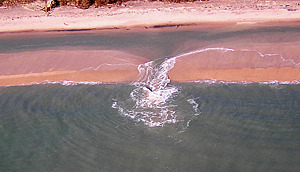|
Rip Currents
Rip currents are powerful, channeled currents of water flowing away from shore. They typically extend from the shoreline, through the surf zone, and past the line of breaking waves. Rip currents can occur at any beach with breaking waves, including the Great Lakes.
 Rip currents most typically form at low spots or breaks in sandbars, and also near structures such as groins, jetties and piers. Rip currents can be very narrow or extend in widths to hundreds of yards. The seaward pull of rip currents varies: sometimes the rip current ends just beyond the line of breaking waves, but sometimes rip currents continue to push hundreds of yards offshore. Rip currents most typically form at low spots or breaks in sandbars, and also near structures such as groins, jetties and piers. Rip currents can be very narrow or extend in widths to hundreds of yards. The seaward pull of rip currents varies: sometimes the rip current ends just beyond the line of breaking waves, but sometimes rip currents continue to push hundreds of yards offshore.
Rip currents form as incoming waves create an underwater sandbar close to shore (#1 above), and the waves push more and more water in between the sandbar and the shore (#2) until a section of this sandbar collapses and the water rushes back toward the sea (#3) through a narrow gap. Once the flowing water pass through the narrow gap it begins to spread out (#4). It is here where the velocity and strength of the rip current circulation begins to weaken considerably.
Rip currents can be killers as they are the leading surf hazard for all beachgoers. They are particularly dangerous for weak or non-swimmers. Rip current speeds are typically 1-2 feet per second. However, speeds as high as 8 feet per second have been measured which is faster than an Olympic swimmer can sprint!
 The United States Lifesaving Association estimates that the annual number of deaths due to rip currents on our nation's beaches exceeds 100. Rip currents account for over 80% of rescues performed by surf beach lifeguards. The United States Lifesaving Association estimates that the annual number of deaths due to rip currents on our nation's beaches exceeds 100. Rip currents account for over 80% of rescues performed by surf beach lifeguards.
The drowning deaths occur when people, pulled offshore, are unable to keep themselves afloat and swim to shore. This may be due to any combination of fear, panic, exhaustion, or lack of swimming skills.
Dispelling the Myth of the Rip
A rip current is a horizontal motion not a vertical motion. Rip currents do not pull people under the water; they pull people away from shore. The rip current is typically the strongest about a foot off of the bottom, which can cause your feet to be knocked out from under you making it feel like something under the water was pulling you. This is where the incorrect term "undertow" comes from.
Also, another incorrect term used for rip currents is the "rip tide". Rip currents would exist with or without tides. However, low tide can enhance the intensity of the current.
|
|





